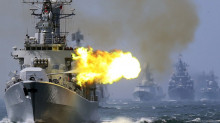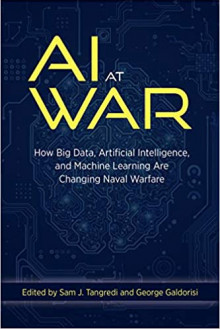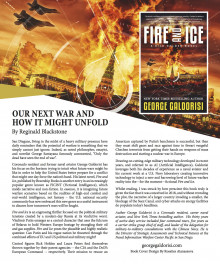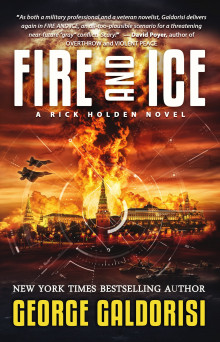Recently, USNI press has published a book edited by Sam J. Tangredi and George Galdorisi entitled AI at War: How Big Data, Artifical Intellignece and Machine Learning are Changing Naval Warfare.
The book provides a useful overview to various perspectives on how AI and autonomous systems might shape the way ahead with regard to the evolution of warfare.
I would suggest the might shape point.
In effect, the art of warfare is changing under the impact of several forces for change, not simply how data is managed or how machines might operate as force extenders for manned platforms.
In reality, the book really focuses on command and control, and many of the chapters focus on that subject.
The shift from the land wars back to peer competitor warfare is built around the return of mission command and C2 as the heart of shaping the way ahead for distributed forces.
The standup of Second Fleet in Norfolk and the associated commands under VADM Lewis’s leadership are being crafted into a warfighting force around mission command and distributed C2 and reworking task force concepts.
Autonomous systems and better information management will enhance the lethality, survivability and capability of such a force, but that is the mid-term.
But without working the core concept of operations shifts, adding new machines will not have the impact they might have.
A good way to look at this dynamic is provided in the chapter by Harrison Schramm and Bryan Clark.
“A more disaggregated and reconfigurable force structure would enable a wider variety of potential force presentations. An AI-enabled control system could exploit the composability of a disaggregated force to create greater adaptability for the U.S. military and impose more dilemmas and complexity on an adversary, thereby increasing the opponent’s uncertainty.”
In my work with the Australian Defence Force and the recent Williams Foundation Seminar on Next Generation Autonomous Systems this is a key focus of attention for the ADF.
Reshaping the maritime force to operate as a fleet, and to do so in terms of blue water expeditionary operations is the foundation from which a transition to use effectively autonomous systems within which AI would play a decision guidance role is foundational.
There are several thoughtful chapters on C2 as the U.S. Navy turns its focus to peer warfare.
But as it does so there are three very important considerations which affect big data, AI and its use.
The first is that the peer competitors we are talking about are nuclear powers, so that any consideration of how to manage attacks upon peer adversaries must consider how those attacks affect the calculations of adversaries.
The second is that understanding of how adversaries think and how they might act is part of the calculation which AI processing of data can assist if we indeed have the knowledge to know what we are looking for and what we are looking at.
This is a huge gap as we turn from being Middle East experts to calibrating how authoritarian leaders in Russia and China under the global stress of COVID-19 and the post-globalization era looks like and how best to use military tool sets?
The third is the question of targeting.
There is a good treatment of the targeting or fires solution problem by Michael O’Gara.
He provides a cautious and careful assessment of how AI can help in the decision process to make a fires solution.
As he notes: “AI holds promise in handling resource priorities across domains more seamlessly while being capable of initiating responses based on more accurate and timely threat assessments.”
But of course, the core targeting problem is not simply the speed to attack but also target selection in a crisis management setting.
But if confidence in both the speed and accuracy to attack is high and can be assisted by more rapid and effective data management and decision tools, then that can assist in providing for a wider set of crisis management options, from the standpoint of decision-making confidence as well.
The book does consider as well the problem of ability to spoof AI-enabled systems.
But there is as well the potential for distributed fleets to develop packages which they can deploy to deceive the adversary as well, even in terms of effective operating location.
The US Navy’s Nemesis program is suggestive of such a possibility.
And in considering the future, it is important not to ignore the warfighting advantages our force already has that the adversary does not.
For example, the ability of an 8-ship F-35 formation to fight as a wolfpack, suggests what swarming could deliver in the midterm future.
The ability of U.S. and allied F-35s to operate over large areas like the North Atlantic and the Mid-Pacific to shape a COP and target identification has barely been scratched. These are harbingers of things to come, but they are here now.
The future is now.
The mid-term and long-term future are just that and mostly unknowable.
How well did the forecasters in 2019 do in forecasting 2020?
The book provides a very useful collection of essays which frame ways to think about AI, big data and C2 might change the future of warfare. It is well worth reading.
https://www.usni.org/press/books/ai-war
Author’s Note: In a recently published Australian study on AI and the military, Peter Layton provided an interesting look at how to consider different ways AI-enabled assets might play out on future battlefields.
The conclusion to his study provides a very helpful and balanced look at the way ahead with regard to AI and warfare:
In the near-to-medium term, AI’s principal attraction for military forces will be its ability to quickly identify patterns and detect items hidden within very large data troves. AI will make it much easier to detect, localise and identity objects across the battlespace. Hiding will become increasingly difficult.
However, the technology of contemporary AI has inherent problems. It is brittle, in being able to operate only in the context it has been trained for; it is unable to transfer knowledge gained in one task to another and it is dependent on data. Accordingly, AI when used in real-world situations needs to be teamed with humans. The strengths of AI can then counterbalance the weaknesses in human cognition and vice versa….
As a general-purpose technology, AI is becoming all-pervasive and will over time infuse most military equipment. Such ubiquity though means AI is likely to be initially employed within existing operational level thinking. In the short-to-medium term, it will enable the battlefield, not remake it.
In simple terms, AI’s principal warfighting utility can be expressed as ‘find and fool’. With its machine learning, AI is excellent at finding items hidden within a high-clutter background. In this role, AI is better than humans and tremendously faster. On the other hand, AI can be fooled through various means. AI’s great finding capabilities lack robustness.
AI’s ‘find’ abilities further provide mobile systems with a new level of autonomy, as the AI can analyse its surroundings to discern important operating data. This means that ‘find and fool’ tasks can be undertaken using in-motion and at-rest, AI-enabled systems featuring varying levels of autonomy. AI can bring to modern warfighting enhanced sensors, improved kinetic and non-kinetic kill systems, more convincing deception techniques and a wide array of ways to confuse. In this, it is crucial to remember that AI enlivens other technologies. AI is not a stand-alone actor, rather it works in combination with numerous other digital technologies, providing a form of cognition to these.
If being used for defensive tasks, a large number of low-cost IoT sensors using AI edge computing could be emplaced in the optimum land, sea, air, space and cyber locations in a territory in which an attacking force may move across. From these sensors, a deep understanding would be gained of the area’s terrain, sea conditions, physical environment and local virtual milieu. Having this background data accelerates AI’s detection of any movement of hostile military forces across it….
For Layton, the operational shift which AI-enabled warfare entailed could be understood as a shift from the kill chain to the kill web.
The kill chain model used by contemporary military forces tightly integrates the sense–decide–act logic flow. In contrast, the data flow across the large Internet of Things (IoT) field in the mosaic warfare construct creates a kill web, where the best path to achieve a task can be determined and used in near real-time. The use of the IoT field is then fluid and constantly varying, not a fixed data flow as the kill chain model implies. The outcome is that the mosaic warfare concept provides commanders with highly resilient networks of redundant nodes and multiple kill paths. Moreover, the mosaic concept aims to be scalable; the size and elements of the IoT field can be varied as battlefield circumstances demand.








